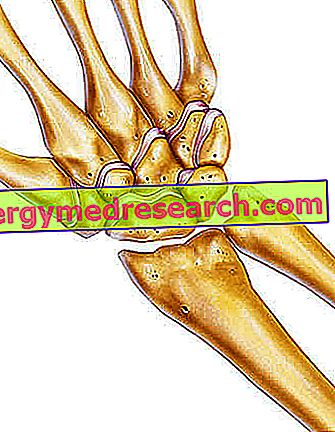Generality
Ischium is one of the three bony components of the iliac bone, together with ilio and pubis.
Specifically, it represents the lower and posterior part of the iliac bone, which is the hip bone. Located inferiorly to the ilium and posteriorly to the pubis, the ischium has three anatomically relevant sections: the body of the ischium, the upper branch of the ischium and the lower branch of the ischium.

Among the anatomical structures that distinguish the above-mentioned sections of the ischium, the following are worth mentioning: the acetabulum (NB: the ischium forms a part of it), the ischial spine, the minor ischial notch, the obturation hole and the ischial tuberosity.
Through the formation of the acetabulum, the ischium contributes to the formation of a very important articulation: the hip joint.
Among the pathologies of the ischium, they include: the avulsion fractures of the ischial tuberosity, the pathologies of the hip and the ischial bursitis.
What is the ischium?
Ischio is one of the three bony portions that make up the iliac bone .
The other two portions of the iliac bone are ilium and pubis .
WHAT IS ILIACO BONE?
The iliac bone, also known as hip bone, is the even and symmetrical bone, which, together with the sacrum and coccyx, constitutes that anatomical structure identified with the name of pelvic girdle .
POSITION OF THE ISCHIO COMPARED TO ILIO AND PUBE
The ischium represents the lower and posterior part of the iliac bone.
It resides below the ileum - which is the upper portion of the iliac bone - and behind the pubis - which is the lower and anterior portion of the iliac bone.
Briefly, the ilium is important for its relationship with the sacrum: with the latter it forms the sacral iliac joint . The pubis, on the other hand, is important because it makes contact with the pubis of the contralateral iliac bone, forming a joint known as the pubic symphysis .
THE ISCHIO IS A PART OF THE BONE OF THE BASIN
The iliac bone - with its three sections ilium, ischium and pubis - and the binomial sacro-coccyx represent the so-called pelvic bones .
The anatomists call the lower part of the trunk of the human body the pelvis or pelvis .
Located between the abdomen and thighs, the pelvis includes, in addition to the pelvic bones: the so-called pelvic cavity, the so-called pelvic floor and the so-called perineum.
Anatomy
The anatomists recognize in the ischium three regions of a certain relevance: the body of the ischio, the superior branch of the ischio and the inferior branch of the ischio .

BODY OF THE ISCHIO
The body of the ischium is the bone region bordering on the ilium and below which the upper branch and the lower branch of the ischium develop in order.
The body of the ischium comprises an outer surface, an inner surface and a rear edge:
- The outer surface of the body of the ischium forms part of the acetabulum, to be precise the 2/5 of the latter. The acetabulum is the hollow within which the head of the femur takes place and which serves for the constitution of a very important articulation of the human body: the hip joint ;
- The inner surface of the body of the ischium forms part of the wall of the small pelvis . The small pelvis is the lower portion of the pelvic cavity, hence the lower part of the pelvis.
In fact, it is the back of the outer surface;
- The posterior edge of the ischium body is anatomically important, because it has a triangular eminence, called the ischial spine, and a small hollow just below the ischial spine, called the minor ischial notch .
From the body of the ischium originate the deep transverse muscle of the perineum, the superficial transverse muscle of the perineum and some fibers of the internal obturator muscle.
UPPER BRANCH OF THE ISCHIO
The upper branch of the ischium (or descending branch) develops inferiorly to the body of the ischium, with a slightly backward orientation.
The upper branch of the ischium has three anatomically interesting portions: an outer surface, an inner surface and a back surface.
- Outer surface. Bordered anteriorly by the so-called obturation hole, the external surface gives rise to some fibers of the external obturator muscle, to some fibers of the square muscle of the femur and to some fibers of the large adductor muscle;
- Internal surface. It is the back of the external surface, therefore it has a similar shape to the latter and, anteriorly, it is bounded by the obturator hole.
Constituting part of the wall of the small pelvis, the inner surface is the seat of origin of some fibers of the transverse muscles of the perineum, of some fibers of the ischiocavernosus muscle and of some fibers of the internal obturator muscle;
- Back surface. It is the portion in which a bony prominence is recognizable, called ischial tuberosity (or tuberosity of the ischium ).
On the ischial tuberosity, the human being weighs the weight of the body when it is in a sitting position.
LOWER BRANCH OF THE ISCHIO
Thin and flattened, the lower branch of the ischium (or ascending branch) is the region that continues the upper branch and connects to the pubis (or pubic bone); to be precise, it connects to the inferior branch of the pubis. In joining the pubis, it forms a structure called the ischio-pubic branch . The ischio-pubic branch contributes significantly to the constitution of the aforementioned obturation hole. Through the obturator hole, the obturator nerve, the obturator artery and the obturator vein pass.
Returning to the lower branch of the ischium, this includes four anatomically interesting portions: the outer surface, the inner surface, the medial edge and the lateral edge.
- Outer surface. On the external surface of the lower branch of the ischium originate some fibers of the external obturator muscle and some fibers of the large adductor muscle;
- Internal surface. In fact it is the back of the outer surface. It constitutes a part of the wall of the small pelvis;
- Medial border. It is thick, rough and slightly everted. It delimits part of the opening formed by the small pelvis.
It has two crests, one external and one internal, which are the continuation of two other ridges located on the inferior branch of the pubis.
On the outer ridge the deep layer of the so-called Colles strip is inserted; on the internal crest, the lower band of the urogenital diaphragm is inserted.
At some point in their path, the two crests join together: this occurs at the point of origin of the transverse muscles of the perineum;
- Side edge. It is thin and sharp. Contributes to the formation of the obturator hole.
LIGAMENTS
The ischium inserts at the terminal end of the sacrotuberous ligament and at the initial end of the sacrospinous ligament .
Formed by three broad bands of fibrous tissue, the sacrotuberous ligament plays an important stabilizing action during the nutation movements of the sacrum.
Thinner than the sacrotuberous ligament, the sacrospinous ligament has the task of opposing the forward inclination of the sacrum, compared to the two iliac bones.
Origin | Term | |
Sacrotuberous ligament | Lateral margin of the wing of the sacrum | Ischial tuberosity |
Sacrospinous ligament | Spine ischial | Partially, on the lateral margin of the wing of the sacrum and partly on the transverse process of the coccyx |
Development
The three sections of the iliac bone - ilium, ischium and pubis - are fused together.
The fusion of the aforementioned sections is a process that takes place in the human being around the 14th / 15th year of life.
Function
The pelvic bones, of which the ischium is in fact one of the various components, have at least three noteworthy tasks:
- Support the upper part of the body;
- Connect the axial skeleton (which includes the skull, the vertebral column, the thoracic cage etc.) to the lower limbs;
- Give insertion to muscles, ligaments and tendons, fundamental for walking and not only.
ISCHIO AND ANCILLARY ARTICULATION
By participating in the formation of the acetabulum, the ischium enters the list of components that make up the hip joint.
The hip is important because it allows the human being to stand upright, walk, run, jump etc.
Note : all three portions of the iliac bone participate in the formation of the acetabulum, so not only the ilium but also the ischium and pubis.
Associated pathologies
Among the pathologies that can affect the ischium, the avulsion fractures of the ischial tuberosity, the hip pathologies, with specific involvement of the acetabulum, and the ischial bursitis certainly deserve a mention.
ANCIENT PATHOLOGIES
The two most important hip pathologies, which can derive from an abnormality of the acetabulum, are: coxarthrosis (or osteoarthritis of the hip) and congenital dysplasia of the hip .
ISCHIATIC BAGS
Ischial bursitis is the inflammation of the synovial bursa located between the large gluteal muscle and the ischial tuberosity. Generally, to cause this condition is to sit for many hours on hard surfaces.
ISCHAN-HAZARD FRACTURES
Doctors define avulsion fractures as all bone fractures that occur due to abrupt and violent muscle contraction.
The avulsion fractures of the ischial tuberosity are injuries typical of those who practice sport, as these individuals are more exposed, compared to sedentary people, to problems of muscular type (contractions, strains, etc.).
The sporting activities in which it is easier to run into an avulsion fracture of the ischium are: soccer, American football, basketball, martial arts and obstacle race.



